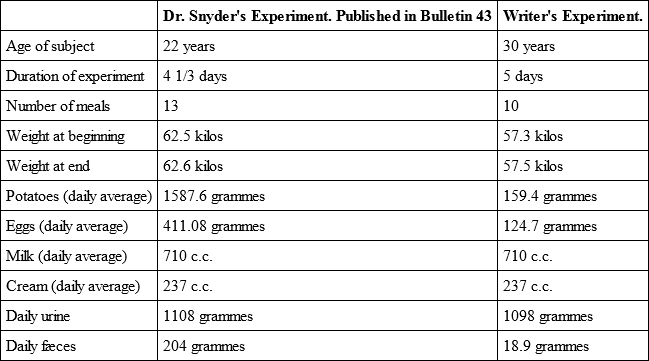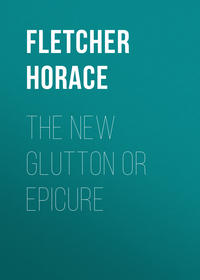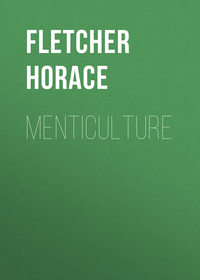 полная версия
полная версияFletcherism
After his cure, he was accepted without difficulty for insurance, the last examination finding him an unusually healthy subject for his age. Having leisure, he had spent three years in investigating the cause of his cure, had pursued experiments upon others, and had extended his inquiries, both in America and Europe, until our meeting in Venice. He had also published a statement and inquiry in book form, entitled "Glutton or Epicure," which had been reviewed by the "Lancet."
For nearly a year I also had been experimenting on myself and others with various diets, and was ready to believe that in the manner of taking food and not altogether in its varying matter lay perhaps its protean effects on our system. I at once adopted the same method of eating. At the end of six weeks, I noticed that not only did the fauces refuse to allow of the passage of imperfectly prepared food, but that such food was returned from the back to the front of the mouth by an involuntary, though eventually controllable, muscular effort taking place in the reverse direction to that occurring at the inception of deglutition.
What actually happens is this: Food, as it is masticated, slowly passes to the back of the mouth, and collects in the glosso-epiglottidean folds, where it remains in contact with the mucous membrane containing the sensory end-organs of taste. If it be properly reduced by the saliva it is allowed to pass the fauces, – a truly involuntary act of deglutition occurring. Let the food, however, be too rapidly passed back to these folds, i. e., before complete reduction takes place, and the reflex muscular movement above referred to occurs. The process of this reflex is as follows: The tip of the tongue is involuntarily fixed at the backs and bases of the lower central incisor teeth by the anterior fibres of the geniohyoglossi muscles. With this fixed point as fulcrum, the lower and middle fibres of these muscles, aided by those of the stylohyoid and styloglossi muscles raise the hyoid bone, straighten out the glosso-epiglottidean folds, passing their contents forward, by the fauces, the opening of which is closed by approximation of its pillars and contraction of the superior constrictor. The tongue, arched postero-anteriorly by the geniohyoglossi, palato, and styloglossi muscles, laterally, by its own intrinsic muscles, is approximated to the fauces, soft and hard palates in turn, and thus, the late contents of the glosso-epiglottidean folds are returned to the front of the mouth for further reduction by the saliva preparatory to deglutition.
The word reduction is used for the reason that all foods tested, without exception, give an acid reaction to litmus, when served at table. The reflex muscular movement occurs in the writer's case from five to ten times during the mastication of each mouthful of food, according to its quantity and its degree of sapidity. As often as it recurs, the returned food continues to give an acid reaction, while food allowed to pass the fauces is alkaline.
Saliva, flowing in response to the stimulation of taste, seems more alkaline than that secreted in answer to mechanical tasteless stimulation. It is found that the removal of original taste from any given bolus of food coincides with cessation of salivary flow and complete alkaline reduction. The fibre of meat, gristle, connective tissue, the husk of coarse bread and cellulose of vegetables are carefully separated by the tongue and buccal muscles and rejected by the fauces. To swallow any of these necessitates a forced muscular effort, which is abnormal.
Adult man was not originally intended to take his nourishment in a liquid form, consequently all liquids having taste, such as soup, milk, tea, coffee, cocoa, and the various forms of alcohol, must be treated as sapid solids and insalivated by holding them in the mouth, moving the tongue gently, with straight up and down masticatory movements, until their taste be removed. Water, not having taste, needs no insalivation and is readily accepted by the fauces.
In explanation of the phenomenon described, the following theory is advanced: The fauces back of the tongue, epiglottis, in short, those mucous surfaces in which are placed the sensory end-organs of taste and "taste buds" (the distribution of which, by the way, has yet to be explained), that these surfaces, readily becoming accustomed to an alkaline contact by excessive insalivation and consequent complete alkaline reduction of the food, afterwards resent an acid contact and express their resentment by throwing off the cause of offence by the muscles underlying them.
This phenomenon must not be confused with the cases of rumination and regurgitation, which from time to time are recorded. The food in this case is not swallowed, nor does it pass any point from which it can be regurgitated. Eighty-one individuals of different nationalities and from several classes of society whom we have studied are now in conscious possession of their reflexes. These seem readily educated back to normal functions by all who seriously and patiently adopt the habit of what seems only at first to be excessive insalivation.
The dictum "bite your food well" that we so often use, has no meaning to those suffering from the results of mal-assimilation and mal-nutrition, especially should they have few or no teeth of their own. I make so bold as to state that dyspepsia et morbi hujus generis omnis will cease to exist if patients be persuaded to bite their food until its original taste disappears, and it is carried away by involuntary deglutition.
The important point of the whole question seems to be this alkaline reduction of of acid food before it passes on to meet subsequent digestive processes elsewhere, which then become alternately acid and alkaline.
In the first few months of infant life, when saliva is not secreted, Nature ordains that mammary secretion be alkaline. With the eruption of teeth come an abundant flow of saliva and a synchronous infantile capacity for managing other foods. This flow of saliva depends on a thorough demand and use to maintain its generous supply. It is just at this time that children learn to bolt their food, – the demand fails, with a consequent detriment to the salivary glands, digestive processes, and the system generally.
A, B, C, and D were placed on an absolute milk diet. A drank his milk in the ordinary way, and at the end of three days begged to discontinue the experiment owing to disgust at the monotony of the diet. B, C, and D continued the experiment for seventeen days, insalivating the milk, but to a varying extent, B the least and D the most. Though D took most milk, he excreted least solid egesta, C excreting less than B. Can one infer that increased insalivation of a non-starchy food insured its better digestion and assimilation? Each subject took as much milk only as his appetite demanded, D taking the most, which never exceeded two litres daily. The weights of the subjects after the usual sudden drop of the first three days remained remarkably even until the end of the experiment. B, C, and D all relished the diet, and it satisfied the requirements of their appetites, but they experienced an increasing monotony.
As long ago as the seventeenth century, before the transformation of matter into energy by the animal organism, known as Metabolism, was understood, the fact was recognised that by the lungs, kidneys, skin, and intestines, substances no longer useful to the organism were eliminated, the retention of which proved harmful. The nature of these substances was unknown, but it was noted that however much the food was increased the weight of the body remained the same. In other words, a state of complete nutritive equilibrium was maintained.
The following table contains the résumé of two experiments in which a state of complete nutritive equilibrium was maintained by individuals of about the same weight, on widely different quantities of food similar in quality. The subjects of the experiments were a laboratory assistant of Dr. Snyder, of the U. S. Department of Agriculture, and the writer. The experiment of the former was made primarily to show the relative digestibility of the several articles of diet, potatoes, eggs, milk, and cream:

The daily diet of Dr. Snyder's subject consisted of three and one-half pounds of potatoes, eight eggs, a pint and a half of milk, and half a pint of cream. The writer's diet of twelve ounces of solid food (like Luigi Cornaro) consisted of three eggs, the remainder of the twelve ounces in potatoes, and an equal quantity of similar liquid food to that taken by Dr. Snyder's subject. The exercise of the laboratory assistant comprised his daily routine of laboratory work, while that of the writer consisted of six sets of tennis, or an hour and a half on horseback, with an hour to an hour and a half's walk or climb daily, in addition to much reading and writing.
In each case complete nutritive equilibrium was maintained, although the author subsisted on three-seventeenths of the solid food taken by the other subject.
Again, cannot one infer that better assimilation and less waste resulted from the better preparation of the smaller quantity of food by insalivation? Surely, too, there must be less daily strain on the intestinal canal, and body generally, in getting rid of 18.9 grammes of inoffensive dry waste, than in getting rid of 204 grammes of humid, decomposing, and offensive matter.
"Considerable importance has been attached to the normal action of the bacteria in the intestines; and it has even been supposed that the presence of bacteria is essential to life. Such a view has recently been shown to be erroneous by an elaborate and painstaking research carried out by Nuttall and Thierfelder, who obtained ripe fœtal guinea-pigs by means of Cæsarean section carried out under strict antiseptic precautions. They introduced the animals immediately into an asceptic chamber through which a current of filtered air was aspirated, and fed them hourly on sterilised milk day and night for over eight days.
"The animals lived, and throve, and increased as much in weight as healthy normal animals subjected to a similar diet for the purpose of controlling the results. Microscopic examination at the end of the experiment showed that the alimentary canal contained no bacteria of any kind, nor could cultures of any kind be obtained from it.
"The same authors, in a subsequent paper, described the extension of their research to vegetable food. This was also digested in the absence of bacteria. Under such conditions cellulose was not attacked. Hence they consider that the chief function of this material is to give bulk and proper consistency to the food so as to suit the conditions of herbivorous digestion." (Schäfer's "Text-Book of Physiology," vol. i., p. 465.)
Now, inasmuch as bacterial digestion has no place in the animal economy, surely it can only occur at the expense of the organism?
Can micro-organic action take place in the intestines without the production of toxins and the consequent absorption of these toxins into the blood?
We know that the metabolism of a cell is determined by the general physical environment of the whole organism, by supplies of oxygen and water, on nervous impulses, and, what chiefly concerns this argument, on the nature and amount of the pabulum supplied to it. This pabulum is derived from the alimentary canal.
Are not even those of us who may be enjoying seemingly the best of health supplying to our tissues pabulum containing mild toxins, thus causing an increased katabolic action to occur in each individual cell of our bodies?
Are not the blood elements, floating in a plasma containing such toxins, rendered resistant, weaker, less capable of fulfilling their functions as carriers and combatants of disease?
Are not their and our lives, in consequence, more painful and shorter than they need be?
Would not the elimination of these toxins render us less liable to disease? And is not their presence an important element in predisposition to disease?
When this reflex is restored micro-organisms get no further than the stomach. They are destroyed there by the acid gastric juices, then only stimulated to their full and normal secretion by the presence of a sufficiency of alkaline substance. Undigested matter having been eliminated, micro-organisms, still existing in the intestines, deprived of their means of subsistence, decrease, and, in time, may cease to exist. The body no longer absorbs the toxins these produced. To this fact may be ascribed the increase of mental energy, the general physical betterment, the cessation of morbid cravings for food and drink and of those of a sexual nature, which are noticed and experienced.
What has just been stated is based not entirely on experimental evidence but somewhat upon inference. The inference seems justified because the excreta, more especially of the intestines, but also of the kidneys and skin, become almost odourless and entirely inoffensive. The solid egesta are voided thickly covered with mucus, leaving the end of the bowel dry and clean. The sense of cleanliness can only then be appreciated to the full, for it is internal as well as external. Flatus is no longer produced. The urine is inoffensive and seems to be materially changed in quality, as shown by chemical analysis. Uric acid, the chlorides, and, more markedly, aromatic sulphates are reduced in quantity.
Owing to deliberation in eating, necessitated by this new habit, satiety occurs on the ingestion of considerably less food. By carefully studying one's self I believe it possible to cultivate an instinct which will regulate not only the quantity but the quality of food that the body may need, and that in the normal health of a full-grown body, no more food either in quantity or quality should be supplied than suffices to supply diurnal waste. Any excess must result in pathological processes.
Although there results enhanced pleasure in the taking of all foods, rich and simple, and especially in the appreciation of good wines, the quantities of these foods and beverages that suffice to fully satisfy the appetite are much smaller than before, while there is a marked preference for the simpler kinds of food. The writer now can imagine no more pleasurable meal than one consisting of good brown bread, eggs, butter, cheese, and cream. These, with fresh vegetables and a very little fruit, form his staple diet. This tendency and preference for simple foods is the general experience among those who have recovered their reflexes of deglutition.
Following on the ingestion of a lessened quantity of food and on its better assimilation, there is less waste, the egesta are voided less frequently, sometimes only once in five to eight days.
The lower bowel is not the reservoir it formerly was. So hæmorrhoids cease from troubling and constipation cannot exist. For this same reason the body, at the beginning of the practice, commences to approximate to its normal weight, increasing or decreasing as the individual's environment demands.
A few more words only need be said. It has been easy to state the results of experiments and observations: but the acquiring of this new reflex, while pursuing daily occupations, is not easy, and needs more than a little patience and much serious thought. The habits of a lifetime cannot be changed in a few days or weeks. The shortest time in which the reflex has been re-established is four weeks, and this only by avoiding conversation at meal-time and concentrating the attention on keeping the food in the mouth until complete alkaline reduction has taken place and sapidity has disappeared.
In closing I wish to maintain as a fact, gentlemen, of the truth of which you will only be convinced by actual experience, that by the restoration of this reflex and in complete dependence on its use, there lies true health, the establishment of a condition of stable nutrition and the possible abrogation of two great predisposing factors of disease, mal-assimilation and mal-nutrition. Unless there be among you, as in the "Cities of the Plain," a parlous minority who possess this reflex and take your food as you ought, none of you are in the enjoyment of such health as you might have. A like punishment will be meted out to you as was visited on those cities, for you will all be consumed long before your day by the unnecessary combustion in your bodies caused by the circulation in them of toxins, the product of undigested and decomposing food.
The writer, bearing in mind the warning suggested by the Frenchman whose donkey died as soon as he had reduced his food to a single wisp of straw, finds that he is taking less and less food. While his mind is open as to his arriving at the final diet of Luigi Cornaro, yet it is easily conceivable that living a similar life of retirement in a placid environment, it would be quite possible to do as he did. Hence the title of this paper and the queries at the commencement.
The objects in publishing and distributing this paper are twofold: to make the subject as widely known as possible, and to solicit the aid of colleagues in investigating it more fully.
There is ready at the service of the general practitioner an important and potential therapeutic agent in the saliva of his patients and in the use ad finem of their salivary digestions.
Editor's notes. (1) Confirmatory evidence of the correctness of the deductions made in this paper has begun to come in from many professional sources and notably from a famous child specialist who avers that children would follow the natural requirements in eating were it not for artificial food, bad example, and bad teaching.
(2) In a report of a paper read before the Société de Biologie, Paris, France, March 15th, 1902, by M. Max Marckwald, of Kreuznach, "On Digestion of Milk in the Stomach of Full-grown Dogs," the following appears: "Hence these experiments confirm those of Horace Fletcher and Ernest H. Van Someren on the importance of prolonged mastication" (translation). Referring, as the latter statement does, to mastication (insalivation) of liquid, it gives an important suggestion relative to some probable causes of uncertain or defective digestion in human nutrition.
1
Note: – Some of these same friends, fifteen years later, when I was sixty-four years of age, as positively declared: "You never looked so well: Fletcherizing has certainly done well for Fletcher!"
2
Professor W. A. Atwater, of Connecticut, U.S.A., was, in his time, a respected authority in the field of human nutrition, and, as such, was selected by the editors of the Encyclopædia Britannica to write the chapters on Nutrition for the Encyclopædia.
3
Dr. Van Someren's testimony is given as an Appendix to this volume; taken from The A.B. – Z. of Our Own Nutrition.
4
Now Chief of Staff.
5
The full report of this famous experiment may be found in Professor Chittenden's book Physiological Economy in Nutrition; but such small mention of indebtedness to Fletcherism was made, that Professor Irving Fisher, in the interest of practical Political Economy, organised a supplemental experiment, more normal than the first, to test the economic effects of Fletcherism, pure and simple.
A brief account of this investigation is given on page 98.
Professor Chittenden made amends, later on, by composing a physiological prose poem on the benefits and delights resulting from careful chewing and tasting of nutriment, which I quote in full in Chapter VII.
6
Detailed account of this test is given in The New Glutton or Epicure, New York: Frederick A. Stokes Company.
7
Forwarding muscular movement which advances food along the whole extent of the alimentary canal.
8
The organic materials of human diet are usually classified into three divisions: —
(1) The Proteids, or Albuminates – the characterising element occurring being nitrogen. The nitrogenous foods are: flesh (without the fat), eggs, milk, cheese, legumes (peas, beans, lentils, etc.).
(2) The Fats, or Hydro-carbons. All animal and vegetable fats and oil. Emulsions of mineral oils have been shown to pass through the system unchanged, and therefore cannot be regarded as food.
(3) The Carbohydrates (sugars and starches): bread, potatoes, and grain generally.
Protein is the tissue builder; heat and energy are derived largely from the non-nitrogenous foods.
A Calorie (large) is the unit of heat required to raise one kilogram of water to 1 °C. The full value of a food is ascertained by means of the calorimeter, or apparatus used to determine the specific heat of substances, or the amounts of heat evolved or absorbed in various physical and chemical changes. Calorimeters take very diverse forms, varying from quite simple vessels to highly complex apparatus, according to the particular kind of determination to be carried out in them.
9
Although I have been a close student of the subject for more than fifteen years in the best physiological-chemical laboratories for long periods of time – and always emulating the man from Missouri in demanding of the wise ones in the science of the laboratories to "Show me!" – I make the statements relative to what happens below the guillotine line in Mother Nature's exclusive territory of responsibility on the authority of the laboratory territory experts; but only, mind you, when my personal observations and business logic approve the conclusion. Therefore, when I tell you that starch turned into dextrose, or "grape sugar," is assimilable as nourishment, and that starch which is not thus chemically transformed by saliva is not capable of becoming nourishment, I am not "speaking by the book," which Mother Nature has opened for me to read – unless biological-chemists can be considered to be extra-enlightened forms of nature.
10
Dr. Prof. J. P. Pawlow, Director of the Department of Experimental Physiology in the Russian Imperial Military School of Medicine, &c.
11
Literally "Butter-goose"; a table set apart, with bread and butter and a variety of snacks.
12
Dr. M. Hindhede: Copenhagen, Denmark.
13
Voit, Atwater, etc.
14
Carl Voit, of Munich, prescribed as Standard daily diet for a man doing moderate work: 118 grams of Protein, 56 grs. Fat, 500 grs. Carbohydrates, with a total fuel value of 3,055 large calories; increasing the same to 145 grams Protein, 160 grs. Fat, 450 grs. Carbohydrates, with a total fuel value of 3,370 large calories. This is the celebrated Voit Diet Standard. Professor Atwater, of Connecticut, went further, prescribing as Daily Diet Standard no less than 125 grams of Proteins, with sufficient fat and carbohydrates to equal a total fuel value of 3,500 large calories for a man doing a moderate amount of labour; increasing the amount of Protein to 150 grams, with fats and carbohydrates to a total fuel value of 4,500 large calories per diem.
15
This reference is to an unique experiment in New York, account of which will sometime be published under the title of "Parties of Politeness," a name suggested by the little guests themselves.
16
It is not outside the province of Fletcherism to Fletcherize our vocabulary and make it as single-meaning as possible in the interest of simplicity. The term "Fletcherize" is already commonly used to suggest analysis and digestion of crude raw material other than food, and has come into use in literary circles with especial usefulness. Young reporters on newspapers are often told by editors to take their "copy" in hand and "Fletcherize" it before handing it in for printing. Even such a judicial person as Mayor Gaynor, of New York, had recourse recently to such advice relative to evidence, but he called it by a name of his own not yet in common use.







